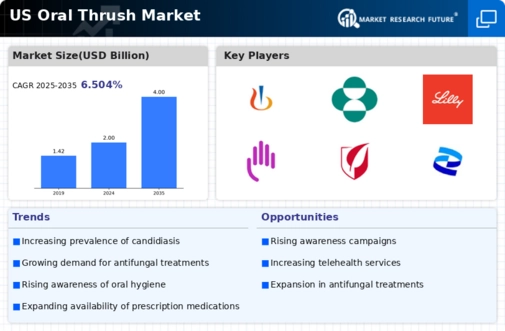Expansion of Healthcare Access
The oral thrush market is influenced by the expansion of healthcare access across the US. Initiatives aimed at increasing healthcare coverage and reducing barriers to access are likely to result in more individuals seeking treatment for oral thrush. The Affordable Care Act has played a role in improving access to healthcare services, which may lead to higher diagnosis rates of oral thrush. As more patients gain access to healthcare, the likelihood of early intervention and treatment increases, thereby driving the oral thrush market. Furthermore, the rise of telehealth services is facilitating consultations for oral health issues, making it easier for patients to receive timely care and treatment for oral thrush.
Increasing Incidence of Oral Thrush
The oral thrush market is experiencing growth due to the rising incidence of oral thrush among various demographics. Factors such as immunocompromised states, including those with HIV/AIDS or undergoing chemotherapy, contribute to this increase. According to the Centers for Disease Control and Prevention (CDC), the prevalence of oral thrush is notably higher in individuals with weakened immune systems. This trend indicates a growing need for effective treatment options within the oral thrush market. Furthermore, the aging population in the US, which is more susceptible to infections, is likely to drive demand for oral thrush treatments. As awareness of the condition increases, healthcare providers are more frequently diagnosing and treating oral thrush, thereby expanding the market's reach.
Growing Focus on Preventive Healthcare
The oral thrush market is benefiting from a growing focus on preventive healthcare measures. As individuals become more health-conscious, there is an increasing emphasis on maintaining oral hygiene to prevent infections like oral thrush. Educational campaigns by health organizations are promoting awareness about the importance of oral health, which may lead to early detection and treatment of oral thrush. This proactive approach is likely to drive the market as more individuals seek preventive solutions. Furthermore, the integration of oral health into overall health assessments by healthcare providers is expected to enhance the visibility of oral thrush, thereby increasing the demand for related treatments and products in the oral thrush market.
Rising Demand for Antifungal Treatments
The oral thrush market is significantly influenced by the rising demand for antifungal treatments. Antifungal medications, such as fluconazole and nystatin, are essential in managing oral thrush effectively. The market for antifungal drugs is projected to grow, with estimates suggesting a compound annual growth rate (CAGR) of around 5% over the next few years. This growth is driven by the increasing awareness of oral thrush and the need for effective treatment options. Additionally, the availability of over-the-counter antifungal treatments is likely to enhance accessibility for patients, further propelling the oral thrush market. As healthcare providers continue to emphasize the importance of treating fungal infections, the demand for these medications is expected to rise.
Technological Advancements in Diagnostics
The oral thrush market is poised for growth due to technological advancements in diagnostics. Innovations in diagnostic tools, such as rapid testing kits and improved imaging techniques, are enabling healthcare providers to diagnose oral thrush more accurately and swiftly. This efficiency in diagnosis is crucial, as timely treatment can prevent complications associated with the condition. The introduction of point-of-care testing is particularly noteworthy, as it allows for immediate results and treatment decisions. As diagnostic capabilities improve, the oral thrush market is likely to expand, with more patients receiving appropriate care. Additionally, these advancements may lead to increased research and development efforts aimed at creating more effective treatment options.























Leave a Comment